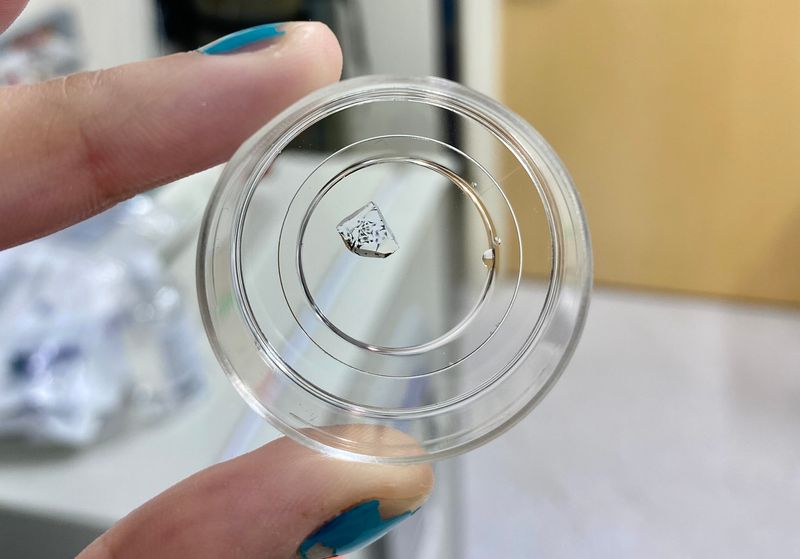Microscopes have been fine-tuned to image cells in granular detail, with the most sophisticated instruments capable of resolving individual atoms within a protein. The expense of microscopes creates an economic divide, however, hindering research at organizations with less funding, says Yale University cell biologist Joerg Bewersdorf. In 2015, scientists developed a technique called expansion microscopy that physically enlarges cells, making some small features large enough to view with simple microscopes. In a preprint uploaded to bioRxiv on December 2, Bewersdorf and his colleague Ons M’Saad further developed the technique, enabling cells to be seen with the naked eye and increasing detail with a simple microscope.
The team developed a two-step strategy that involves both expanding and staining cells, and tested their technique on human cells and mouse brain tissue. First, they submerged the samples in a hydrogel solution containing small compounds that behave as liquid until they link up into polymer chains that absorb water and congeal into a gel. These included sodium polyacrylate, a super-absorbent powder found in diapers. After the cells take in the solution, water absorption swells the gel, physically expanding cells to about the same size as sesame seeds.
“Cells remain invisible by this point because their contents have been diluted 8,000 times with water,” M’Saad tells The Scientist. “We needed to come up with an augmented stain to ‘unclear’ the cells so that they appear vivid.”
The new technique, which the team patented and named “Unclearing Microscopy,” involves two staining methods. The first uses large stainable polymers to augment the signal, making the cell more visible. The research team achieved this by targeting all the proteins in the cell with small molecules that subsequently link up with other compounds under light to produce large polymers that can be stained blue. The other technique involved depositing silver on the sample in increasing concentrations until the researchers determined the optimal dose that, in concert with the other technique, amplified the signal more than 100,000 times. This enhanced the contrast enough to view cells with the naked eye.
See “Scientists Stretch Neurons to Image Fine Structures”
(1) Researchers submerge cells in a hydrogel solution containing sodium acrylate. (2) Water-absorbing polymers of sodium polyacrylate build up to form a gel. (3) Water added to the gel occupies space in between the polymers, causing the gel and cells to swell. (4) Cells are viewed with the naked eye using a stain for protein-rich components.
M’Saad says that using the technique, she could discern the shape of an enlarged cell, and identify the cell’s nucleus and cytoplasm as well as its physical cell-to-cell connections—all with her naked eye. A standard benchtop microscope illuminated with a simple lamp could now be used to discriminate microscopic details, such as neuronal synapses in brain tissue as well as cristae, which are the groovelike structures that run through the interior of mitochondria. Without Unclearing Microscopy, features as small as these can normally only be seen using high-powered microscopes. The study notes that Unclearing Microscopy shows promise for large-scale research into neuronal connections in brain tissue.
See “Image of the Day: A Swell Idea”
The report on Unclearing Microscopy’s development has yet to be published in a peer-reviewed journal. But Manu Prakash, a Stanford University biologist who makes microscopes accessible to developing nations and who was not involved in the study, tells The Scientist that “this technique is a game changer. You can now do super-resolution microscopy without state-of-the-art microscopes, and it feels empowering to hold visible cells in your hand.” He notes, however, that it “takes time to master the technique” and that it will need to eventually be simplified and streamlined in order to realize its full potential. M’Saad shares a similar sentiment, saying that was her reasoning for starting a new company called panluminate, which she says aims to develop and sell a reliable and affordable version of the technique.
Bewersdorf says that Unclearing Microscopy could make microscopy research more broadly accessible: “Powerful microscopes can cost $1 million or more, need technical expertise to maintain, and require infrastructure. Unclearing Microscopy, on the other hand, could be carried out in the field cheaply, bridging the funding gap between research centers.”

BLOWING UP: In Unclearing Microscopy, cells are soaked in a hydrogel solution that contains compounds—such as sodium acrylate, which is found in diapers—that enter the cell, absorb water, and form a gel that expands in size. Blue and silver staining techniques target individual proteins and protein-rich components to increase the color contrast of cellular components 100,000-fold, making the cell visible to the naked eye and individual components visible under a simple benchtop microscope.
ASHLEIGH CAMPSALL














